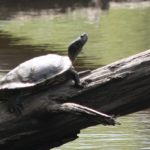When a pair of cyclists rode past me on the bike trail recently, I was staring intently into a shrub. Maybe I looked a little bit deranged, standing there with my notebook. I was watching a baby warbler and, frankly, was having too much fun to care what anybody thought. That’s what a citizen science project can do to you.
In June, I wrote about the Wisconsin Breeding Bird Atlas, a project that relies on “citizen scientists” for collection of statewide data. Citizen science is not a new phenomenon. Nearly 70 years ago in his essay, “Wildlife in American Culture,” Aldo Leopold wrote of amateur naturalists who, in simply pursuing their curiosity, became recognized authorities on their respective subjects.
Today we generally think of citizen science as an organized effort in which volunteers – mostly amateur naturalists – gather data for a project coordinated by professional scientists. You needn’t be a birder to be a citizen scientist. In Wisconsin alone we have programs that monitor turtles, frogs and toads, wolves and other carnivores, the weather…the list goes on, and indeed is so lengthy that you can search by subject or county among dozens of opportunities on the Wisconsin Citizen-based Monitoring Network’s website.
And furthermore, you needn’t be in Wisconsin to find a project. In Iowa, for example, the Department of Natural Resources has a Volunteer Wildlife Monitoring Program that includes frog and toad call surveys, bird nest monitoring, and acoustic monitoring for bats. Volunteers in Texas are helping to map the locations of invasive species, and in Florida they’re monitoring horseshoe crab nesting activity. What fun!
To find opportunities where you live, you could type “citizen science” and your state or region into your search engine. You could also check with your favorite conservation organization or nature center. The Audubon Society, for instance, sponsors the famed Christmas Bird Count and Backyard Bird Count. The Xerces Society needs volunteers to track the movements of migratory dragonflies. The internet makes it easier than ever for groups like these to collect data from far-flung volunteers.
Here in Wisconsin, the Riveredge Nature Center in Saukville is just one of many nature centers nationwide that invite visitors to become citizen scientists by contributing their observations to ongoing phenology projects. (Phenology is the study of seasonal and cyclic natural phenomena: when the first robin arrives in spring, when the first Black-eyed Susans bloom, and so on.)
Aldo Leopold kept phenological records at the Shack for more than a dozen years, and his daughter, Nina Leopold Bradley continued the practice from 1976 until her death in 2011. The records are especially valuable in evaluating the effects of climate change; for this reason, interest in phenology continues to grow. But there’s something more. As Nina Leopold Bradley noted in an interview about the practice of phenology, “The fact that you keep records all of a sudden changes the way you see the natural systems around you.”
For me, citizen science is one more way of participating in the landscape where I live. Following a “protocol” – a prescribed method for observing and recording data – improves my skills as a naturalist. And, as Aldo Leopold observed, it’s fun. In his description of citizen scientists, he wrote, “Do not let anyone tell you that these people made work out of play. They simply realized that the most fun lies in seeing and studying the unknown.” That’s reason enough for me.
Can’t find a citizen science project that suits your interest? Start your own! Or help your favorite nature center launch a phenology project. Guidelines are on the Aldo Leopold Foundation website.
Watch a video of Nina Leopold Bradley discussing phenology and climate change.

